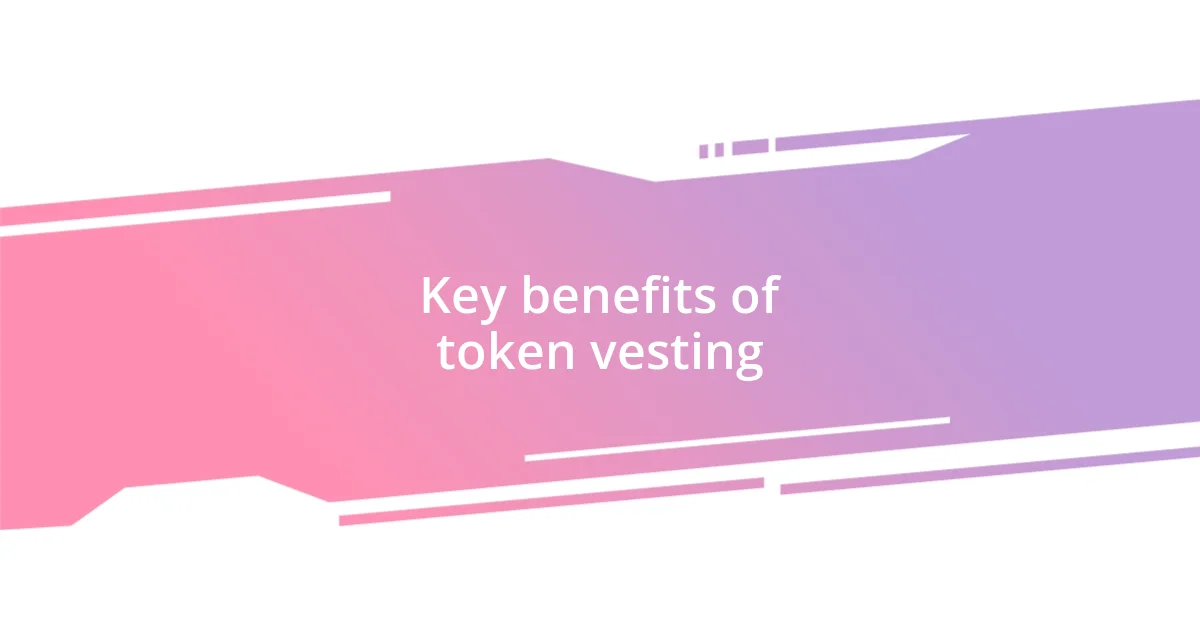Key takeaways:
- Token vesting schedules promote alignment and trust among stakeholders, encouraging long-term commitment and strategic planning.
- Defining clear vesting terms and maintaining open communication are essential to avoid misunderstandings and adapt to changing circumstances.
- Inclusive planning, regular check-ins, and a phased rollout approach can enhance stakeholder engagement and reduce risks during implementation.

Understanding token vesting schedules
Token vesting schedules are crucial in managing how and when tokens are released to stakeholders, including developers and investors. I remember when I first encountered this concept—it felt like unwrapping a complex gift. Initially daunting, I soon realized it’s all about aligning incentives and preventing market flooding.
When we talk about vesting schedules, think about how they protect both the project and its community. For example, in one of my previous projects, we implemented a vesting schedule of four years with a one-year cliff. That means no one could sell their tokens for the first year, ensuring everyone remained focused on the long-term success of the project. Have you ever considered how a poorly structured vesting schedule could impact your investment?
The emotional aspect of vesting schedules can’t be overlooked. There’s a sense of trust that develops when stakeholders understand their tokens are locked for a set period, incentivizing collaboration and patience. I vividly recall discussions with my team about finding the perfect balance—too rigid, and we risk alienating investors; too lenient, and potential pump-and-dump schemes could arise. Isn’t it fascinating how simple structures like these can shape an entire project’s future?

Key benefits of token vesting
One of the primary benefits of token vesting is that it fosters alignment between stakeholders. When everyone knows that tokens will be released gradually over time, it creates a shared vision for success. I remember a project where, after implementing a vesting schedule, the team felt a renewed sense of purpose. The commitment to long-term growth it instilled among us was palpable; we were all in it together for the duration.
Here are some key benefits of token vesting:
- Incentivizes loyalty: Stakeholders remain committed to the project’s success because their tokens are locked for a certain period.
- Controls supply: Gradual token release helps prevent sudden price drops, which can occur from mass sell-offs.
- Encourages strategic planning: With a clear timeline for token unlocks, teams can better strategize future developments and marketing efforts.
- Builds trust: Knowing that tokens won’t flood the market suddenly fosters greater confidence in the project from investors and users alike.
- Strengthens community: A shared commitment to long-term goals cultivates a community that is more likely to engage and support each other.

How to define vesting terms
When defining vesting terms, clarity is key. I often emphasize setting a clear timeline for token releases. In one of my earlier projects, we opted for a monthly release schedule after a six-month cliff. This helped all stakeholders understand exactly when they could expect access to their tokens, creating a sense of transparency that I found invaluable.
Another crucial factor is the percentage of tokens that vest at different stages. I experienced firsthand how offering a higher percentage at critical milestones aligns everyone’s interests. For instance, we decided that 25% of tokens would vest at the end of the first year, ensuring everyone remained motivated to hit our targets. I can’t stress enough the importance of discussing these terms openly with your team to foster trust and prevent miscommunications.
Finally, ensuring that vesting terms are flexible yet firm is vital. In one situation, we faced unexpected market shifts, compelling us to review our initial schedule. Adjusting the vesting terms to reflect new realities, while still safeguarding our long-term objectives, was a delicate but rewarding process. Have you been in a situation where flexibility improved your project outcome?
| Vesting Element | Description |
|---|---|
| Cliff Period | Initial waiting period before tokens start to vest—typically used to ensure commitment. |
| Vesting Frequency | How often tokens are released, such as monthly or quarterly—important for planning and expectations. |
| Percentage Vested | Proportion of tokens released at each milestone, which can motivate stakeholders to meet goals. |

Developing a vesting timeline
When developing a vesting timeline, timing can truly make a difference. I recall a project where we had a straightforward approach: a one-year cliff followed by quarterly vesting. This structure not only gave us six months for our team to establish trust and camaraderie, but it also allowed us to witness tangible growth before tokens started flowing. Doesn’t that create a sense of excitement and anticipation among the team?
I also learned the hard way that communication is essential throughout this process. In another project, we had a miscommunication about our vesting dates which briefly caused confusion and anxiety among the team. It underscored for me how important it is to not just decide on a timeline, but to regularly review it with everyone involved. Are we all on the same page? This question can build a healthier team dynamic while keeping everyone focused.
Finally, I found value in building in some flexibility. In one instance, we adjusted our timeline to extend the vesting period slightly due to unforeseen market conditions. Initially, it felt daunting to change our direction, but in hindsight, that shift allowed us to align better with our community’s sentiment. Have you ever experienced how a slight change in plans can lead to stronger outcomes?

Common pitfalls in token vesting
One common pitfall I’ve observed in token vesting is falling into rigid terms. I remember a project where the team was so focused on the original schedule that when circumstances shifted, we were hesitant to adapt. That rigidity created stress and frustration among stakeholders who felt their growing concerns were ignored. Isn’t it counterproductive to let a pre-set timeline overshadow the project’s overall success?
Another challenge lies in misaligned expectations about vesting terms. In one instance, we anticipated universal buy-in, but not everyone was on the same page. I felt a palpable tension as some team members expressed disappointment over the token release timeline they assumed would be different. This experience made it clear: regular check-ins and transparent dialogue are essential to avoid any misunderstandings. Have you found alignment creates a more harmonious team environment?
Lastly, I often witness teams overlooking market conditions when defining vesting schedules. In a past venture, we set our terms without fully considering external factors. This lack of foresight resulted in a scenario where our token value dropped significantly just as vesting began. It taught me the hard way that staying attuned to the market landscape is crucial for making informed decisions about token vesting. How do you ensure your vesting plans remain relevant in a changing market?

Best practices for successful implementation
One best practice I embraced is the integration of stakeholder feedback into the vesting process. When I was working on a project with a diverse team, we held a series of brainstorming sessions to gather insights on our proposed vesting schedule. It struck me how much trust was built during these discussions; everyone felt heard, which ultimately led to smoother implementation. Have you ever considered how inclusive planning can create a stronger foundation?
Another effective approach I’ve taken is establishing clear communication channels. In my experience, using dedicated platforms for updates and discussions has made a significant difference. For instance, I initiated weekly check-ins where we could openly talk about our progress and concerns. This regular cadence not only reduced anxiety but also fostered a sense of community and collaboration. Isn’t it amazing how a simple routine can transform a team’s dynamic?
Lastly, I found that implementing a phased approach can mitigate risks during the rollout. In a previous venture, we introduced our vesting schedule in stages, which allowed us to assess its effectiveness before full-scale implementation. This strategy provided us with valuable data, enabling us to make necessary adjustments along the way. Have you ever tried a gradual rollout to fine-tune your processes? It’s like testing the waters before diving in.














